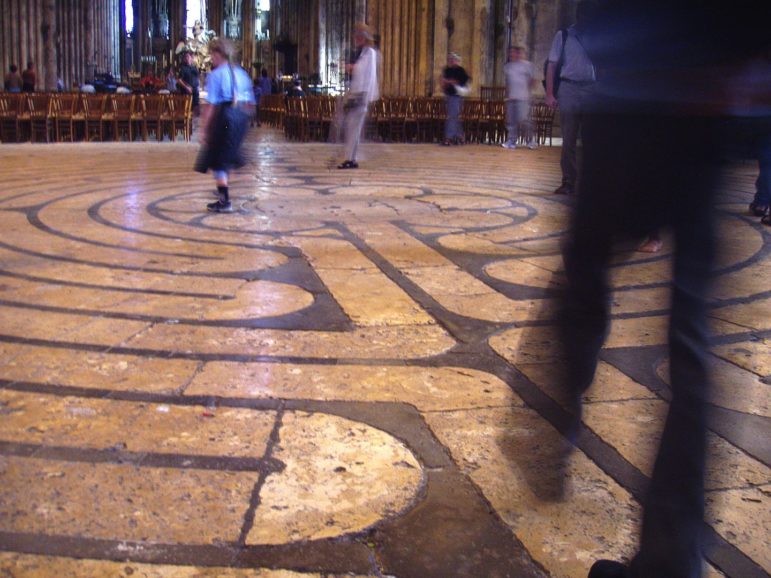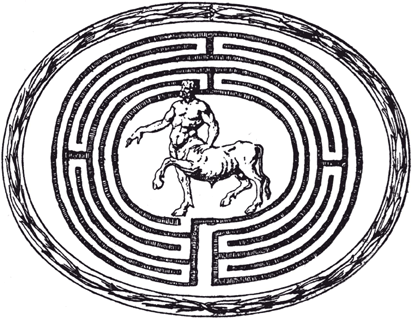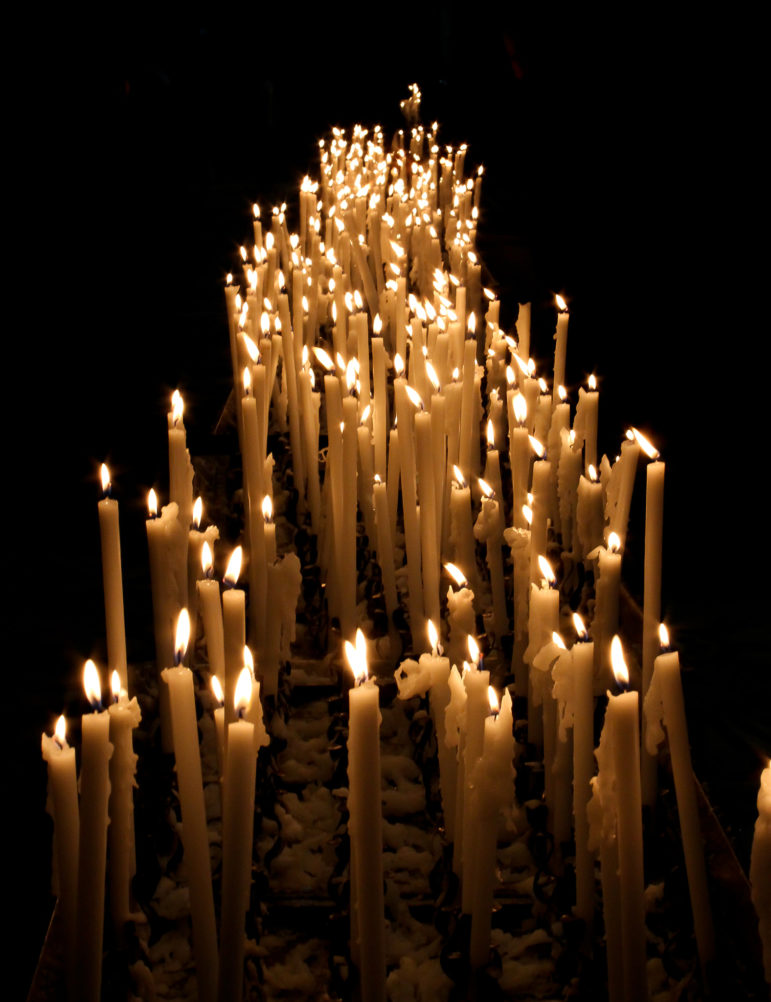
I was younger, then. There were years in front of me, but I have only ever seen the path at my feet, the next few steps. That night, even those steps were difficult to pick out, illuminated by the tea lights that marked out the walls of the labyrinth in the grass. I remember it being a dark sky, clouded or late in the moon’s progress, and enough removed that neither the house or the nascent bonfire added any clarity to where I was walking. As I walked further into the winding path I knew that any misstep would make it easy to pass between two candles that ought to be a wall and break the pattern of circling ever inward. I was determined not to let that happen.
It was Samhain, and I did not know where I was. I had come here with a group of almost strangers, the Exploring Religions club I had joined only a couple of months before, when I arrived at college for the first time. The head of the club had driven us down to a parking lot in Columbia, where we had met a van of people who were strangers even to him. Pagans, he told us, that he had found on the internet. They were having a Samhain event, and he had asked if we could attend.
Right out of high school, I was used to field trips that took me odd places under the direction and supervision of an expert, someone who knew our destination well and was assured of how to get there and back. I treated this trip in the same way – which means that I don’t remember what roads the van of Pagans led us along, out of town and out into the farms surrounding. I don’t recall their names or even the name of the circle. When we drove past the gate and up into the field it never occurred to me that I should be concerned, or that our leader might not know the way back. I did not consider that, perhaps, this group might not have realized that their invitation would be answered by a car full of curious and deeply clueless kids, eager and awkward in the weak light.
I have forgotten many things about that night, over a decade gone. But I remember the labyrinth.

The labyrinth at Chartres Cathedral, 2005 (User Daderot, Wikimedia Commons)
Here are the things to know about labyrinths. They are not mazes. The famous one, the one that shaped so many young Pagans of my generation, with its dead ends and oubliettes, its glam-rock faerie king and friendly monsters, was misnamed. A true labyrinth, the kind from antiquity, from the island of Minos, is a simple path. It doubles back, loops around, holds miles of walking in what seems to be a small space, but it does not offer any opportunities to get lost. There is only one path, in and out.
Walking the labyrinth is, and has been for centuries, a meditative practice. They are built into the floors of medieval cathedrals, large enough to provide a path for the contemplative to follow as they meditate. Today they are often built outdoors, either in the form of hedges or by laying the path out in stones and paving it with dirt. The movement is part of the practice, that continual motion toward a center space, eyes pointed down to mind the path rather than on the distractions of the room. The mind, presented with repetition, under-stimulated, turns inward and upward. Eventually, one’s feet stop moving and the practitioner finds themselves in the center.
The myth tells us that is where the minotaur lives.

(Public domain)
His name is Asterion – we have that name from Pseudo-Apollodorus – but most stories simply call him by his descriptor: “Minos’s bull,” mino-taur. I heard that story when I was very young, in the brightly-colored tales of the D’Aulaires – the king whose wife wanders from the marriage bed and bears a monstrous child. The genius who is commissioned to build an inescapable labyrinth that can imprison the child. The hero who enters, years later, to put the monster to death.
Asterion’s story is where the word “labyrinth” entered my consciousness, and I always imagined his prison as the sort of inescapable maze that I saw onscreen. But the art, Etruscan and Greek, tells me otherwise. Ancient labyrinths are always unicursal – one way in and one way out – with the minotaur standing in the center. It is a shape that makes it impossible to be lost, impossible to imprison someone against their will. Theseus’s enchanted ball of twine, designed to lead him in and back out, is meaningless, a map with one road. And the monster that he faces, the prince with the head of a bull, must be there willingly.
I know now that many Pagan traditions consider this mystery in their practice. I do not think, on that first starry night in Missouri, that the circle I visited called up Minos, or Theseus, or Ariadne, by name. I do not think Asterion was considered as a part of the ritual. But they did call up the labyrinth, laid it out for us and offered its winding path to a still and waiting center.
When I walk a labyrinth, now, it’s that one that I remember. I remember the darkness, straining to pick out the right gaps between candles that were already starting to gutter. I remember being unsure, overwhelmed at my first experience of a religion so different from the bright and stolid churches of my childhood. And I remember the gazebo that served as the labyrinth’s center, with its two robed forms and the dark mirror that they offered me so that I could speak to the dead.
I was younger, then, and still untouched by real loss. I remember taking the mirror that the God offered me and starting to cry. I remember the Goddess, slightly bemused at a child whose greatest loss in the past year had been their dog, comforting me. I remember them being kind but firm as they directed me out so that the next seeker could join them.
I remember being bleary-eyed, missing my step on the way out. I could no longer see where the walls of the labyrinth twisted, or where they meant to lead me. But the bonfire beyond was bright, and there were people singing, and I had already missed one turn. I strode through the gaps in the walls, a not-quite straight line that ignored the path entirely, and went to join them.

“Light Path” (Patricia Meiss Urdaneta, Wikimedia Commons)
It is probably not surprising that, when I finally committed to a Pagan path, it led me back to labyrinths. The first I found near my home, kept by a monastery I had not realized existed. It was laid out by their garden, and kept up well enough by the nuns that, on fine summer days, I could walk it without fear of losing my way. Perhaps, I thought, I needed to walk it again, to find my way out clearly and make up for the time I had so thoroughly broken the rules. Maybe magic was as simple as that – a mistake corrected, a path clarified.
Or maybe I needed to visit the first one, again. Return to my roots, learn about the circle that had set me on this path. I have friends in Columbia still, and I reached out. Was there a circle in town a decade ago that had Samhain rituals in the yard behind their house? Did they know of anywhere that fit the half-remembered description of someone who hadn’t really been paying attention to where they were going? I found a place that fit my best guess and went to visit, paid a fee to camp, and had my own ritual under similar stars.
It didn’t work. I have never been able to shake the idea that, in some way, I have never left that first labyrinth. I am Asterion, contained inside illusory walls that should have no power to trap me. I am forever in the center, the place where the God and Goddess wait, the door to the underworld. Somewhere outside, friendly strangers are raising their voices in songs I do not know. I could leave at any time. I am here by choice. I can no longer find the way out.
I come back to this mystery, whether I seek it or not. A friend tells me the story of Ariadne as I have not heard it before, the goddess of Crete and wife of Dionysos, the lady of the labyrinth. She is betrayed by Theseus; she is never a friend to Theseus. She is the betrayer of the minotaur; she is Asterion’s beloved sister. A friend introduces me to a new order, and they lead me into the space at the center of the labyrinth, seeking transformation. This time, the bonfire is waiting there, and we step into it together, singing.
My path is circular, and as I walk it my language breaks down. There is something at the center. It waits. I know it already. It sits in my chest and just beyond in a direction I cannot name. There is a bonfire, there are shadows cast onto the walls, there is nothing here but what I bring.
I have brought nothing.
I cannot bring something to a place if I am already there.
There are candles in the grass of a stranger’s yard, thirteen years ago. If I could find a way to kneel down properly they would still burn my fingers.
The Wild Hunt always welcomes submissions for our weekend section. Please send queries or completed pieces to eric@wildhunt.org.
The views and opinions expressed by our diverse panel of columnists and guest writers represent the many diverging perspectives held within the global Pagan, Heathen and polytheist communities, but do not necessarily reflect the views of The Wild Hunt Inc. or its management.
The Wild Hunt is not responsible for links to external content.
To join a conversation on this post:
Visit our The Wild Hunt subreddit! Point your favorite browser to https://www.reddit.com/r/The_Wild_Hunt_News/, then click “JOIN”. Make sure to click the bell, too, to be notified of new articles posted to our subreddit.